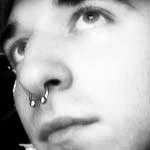TUESDAY
As far as classes went, Tuesday was easily my favorite day of the convention. Things kicked off with the aforementioned Surface Piercing Techniques class, taught by Phish, Luis, and guest Noah Babcock, who took the first third of the seminar to discuss performing surface piercings using Tygon bars as the initial jewelry. His preferred method, Noah insists on scheduling clients not just for their initial appointment, but for three jewelry-changes as well — and charges them all at once to hopefully ensure their return. While there are exceptions to the rule, in his estimation, the pliable Tygon bars are only appropriate to wear for three months at a time, at which point they become stiffer and should be replaced with fresh material. After three rounds of Tygon have been used, the piercings are generally fully healed, and a steel barbell is then bent into the same shape as the final piece of Tygon, which can then be used as a permanent piece of jewelry. I personally was not terribly familiar with this method, though it seemed to be more popular — or at least recognized — than I had realized, judging by the generally informed questions and comments from the audience. Which is another thing: I was absolutely impressed by how well-spoken and intelligent so many of the people in attendance were. Which is not to say I was expecting a bunch of drooling mouth-breathers (ahem, dart convention) — far from it. But in an industry not widely regarded for its great minds, it was heartening to see that pierced and tattooed people are being well-represented on the whole out there — at least professionally.
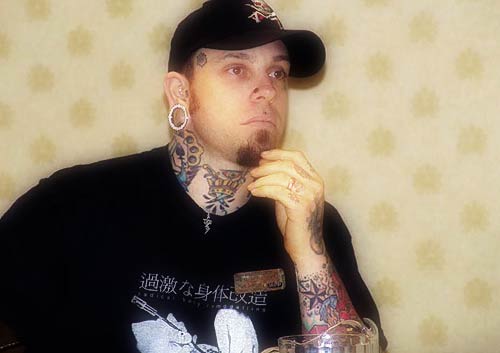
Phish Goldblatt, surface piercing expert
Following Noah’s segment, Phish detailed his own, more common surface bar method, but started off by showing a collection of pantheon-level poorly-done examples of some of the most grisly attempts: Straight barbells for napes, captive bead rings for wrists, and all manner of abscesses, infections, and general weeping. After a detailed explanation (and supplementary videos provided by Luis), the ensuing conversation went off on a series of tangents, the first being punch and taper surface piercing — a method widely regarded as perhaps being superior to using a needle, but one that the APP can and does not have an official opinion on. Why? Because when a dermal punch is put to use rather than a needle, it is no longer a piercing, and is therefore out of bounds for the APP to take an official stance on; for their legislative interests, they can only endorse traditional needle piercings — even when a dermal punch or scalpel is the more appropriate instrument for a procedure.
“But wait,” you ask, “I know some APP members — hell, I know some APP board members — who I’m certain have used dermal punches and scalpels! They’ve even used them on me! What’s the deal?”
The deal is, they’re allowed to use them, but in all likelihood, they will not suggest or recommend them. It’s a funny gray area, it seems, but one of the APP’s goals at the moment is to cease the blurring of the line between piercing and pseudo-surgical procedures — and unfortunately, that involves taking a rather hard-line official stance on the use of pseudo-surgical instruments and tools.
The other widely discussed topic, simply, was just how popular has surface piercing gotten? For some, it’s a non-issue; in spite of demand, they just don’t feel comfortable doing the procedure. Others find they get the odd request, while some are seeing their business dominated by surface piercings — Phish himself claims to do 30-60 of them monthly, which is more business than some piercers get altogether! A popular opinion, as well, was that surface piercings are fundamentally different than regular piercings, and special considerations should be taken with them, from numerous consultations to increased costs; the kicker here, however, was that only a fraction of the piercers who claimed to perform them with any regularity had ever actually had one done personally. At the risk of shooting myself in the foot, I’m going to come out and say that this is unacceptable. While I’m sure there are exceptions to the rule, one eludes me at this time; if you’re going to be a piercer, you should be willing to experience firsthand the sorts of procedures you’re going to be performing on clients. I don’t think this is unreasonable.
One thing I kept hearing was that the APP was taking more chances this year, in that they were willing to go out on a limb and play host to some potentially volatile or controversial talks and classes that would have normally been taboo — the first one that fit this description was a roundtable discussion of suspension, as moderated by Allen Falkner and Ron Garza (IAM:Sicklove). Personally, I didn’t see what the big deal was at first — everyone knew what a suspension was, most people there had taken part in one to some extent, or at the very least probably had a passing interest in the act itself; it seemed perfectly logical to devote an hour out of the week to the topic — it was even being hosted by an APP member.
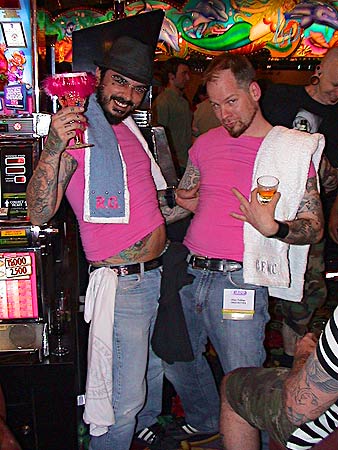
RG, DFWC; Suspension Gurus
The reason this was a big deal was because this was literally one of the first times in the APP’s ten years that the floor had been opened up at their conference to a topic not directly related to piercing or managing a piercing-related business.
(Okay, maybe it still doesn’t sound that impressive, but I could see where they were coming from.)
Starting off with an abridged history of modern suspension practices, the discussion essentially served as a primer for initiates and a reminder course for the experienced. This was likely the most apt approach though; included in the audience were a pair of health inspectors from different states, both of whom seemed somewhat sympathetic to begin with, but looked to be quite impressed by the time things wrapped up. Allen, thankfully, can speak more articulately and persuasively about suspension topics than most others, and was able to deftly lead the discussion through subjects ranging from safety issues (such as how to properly avoid cross-contamination) to the legality of suspension, and even attempted to explain the possibly intangible benefits of the act itself. While he may personally take issue with being called the father of modern suspension — an honor he bestows on others such as Fakir Musafar and Stelarc — there is really no doubt that currently, he is likely the most qualified representative of the suspension community.
And for what may have initially been thought to be a risk, the discussion was well received; it would seem that the members appreciated being given the opportunity to expand their horizons and have a formal forum to discuss issues that, while perhaps not of direct relevance to the industry, are still associated to an extent, and may be subject to potentially overlapping laws. As the saying goes, “A little knowledge is a dangerous thing”, but I think most would agree that no knowledge is incalculably worse.
With that in mind, the final seminar of the day — and, in the eyes of many in attendance, one of the highlights of the entire week — was a talk on the extremes of body modification and how, while perhaps not always done up to APP standards, there is certainly validity to more primitive methods and procedures — presented by BME’s own Shannon Larratt. This seems like a sensible affiliation, does it not? One wouldn’t expect Shannon’s presence as a speaker at a piercing conference to draw much ire or controversy, would they?

The view from the podium
As it turns out, some people do not appreciate what BME is doing — people in the piercing industry. That said, the conference room was packed as people waited in anticipation; some excited, some hoping to have their perceptions altered, and some others seeking to validate their fears and grievances.
Taking a page out of the Ted Kennedy book of public speaking, Shannon approached the podium with his fifth beer of the afternoon; not usually one for this sort of activity, he was initially just as nervous about speaking as many in attendance were about hearing what he had to say. With a PowerPoint presentation at his side, he guided the audience through some potentially traumatizing photos; you know the feeling of camaraderie that develops between people who may not know or like each other when they’re together while something horrible happens, like a car wreck or a Vin Diesel film? That’s what this was like; the subject matter was intentionally grisly, but the worse it got (note: getting an awed hush out of an audience of 250 people can be achieved simply by showing a slide of a man’s ass being pierced by a kitchen knife), people began to understand — themselves, each other, and BME — a little bit better.
One of the points central to Shannon’s seminar was that human beings are inherently designed to heal serious damage; that is, your body is more conditioned to take care of a broken leg on its own than it is to heal a navel piercing. Take the case of the inquisitive fellow whose idea to inflate his genitals with air went awry, resulting in the glans of his penis coming close to it’s literal popping-point — and averting the crisis by cutting holes in the organ with a pair of scissors, thereby letting the air out. While he was at it, he figured, this was as good a time as any to slice open his scrotum and crudely remove other chunks of his genitals. The end result? More scarring than some might care for of course, but generally intact and functioning genitalia, only weeks later.
Less time than it takes some people to heal an eyebrow piercing.
 Blowing through photos of pierced penectomies, deep hand and foot piercings, and the occasional urethral reroute, the audience continued to squirm and laugh nervously for over two hours. A new consciousness was dawning though, and many of these people were becoming aware of facets of their extended community that they had never imagined before; in one of the more unexpected moments of the week, as Shannon wrapped up his presentation, the crowd leapt to their feet and delivered a booming standing ovation for the bashful orator. This was not pandering, sentimental applause — this was the sound of an audience moved and changed by what they had just witnessed and were showing legitimate appreciation.
Blowing through photos of pierced penectomies, deep hand and foot piercings, and the occasional urethral reroute, the audience continued to squirm and laugh nervously for over two hours. A new consciousness was dawning though, and many of these people were becoming aware of facets of their extended community that they had never imagined before; in one of the more unexpected moments of the week, as Shannon wrapped up his presentation, the crowd leapt to their feet and delivered a booming standing ovation for the bashful orator. This was not pandering, sentimental applause — this was the sound of an audience moved and changed by what they had just witnessed and were showing legitimate appreciation.
As one attendee remarked to Shannon afterward: “I didn’t like what you were doing before I came here; I thought it was dangerous and irresponsible. But now I get it.”
Even the health board supervisors couldn’t help but be fascinated by the subject matter, mortifying as it often must have been from a cleanliness perspective; in a crowd full of some of his harshest critics, Shannon delivered one of the convention’s most powerful and appreciated lectures, bar none.
The question and answer period following the presentation was essentially manhandled by Sean Christian (IAM:seanchristian), a fellow whose name I’d heard many times before, but truthfully, he could have been stealing my car and I still wouldn’t have known who he was. A longtime APP member and supporter (and winner of last year’s APP President’s Award), Sean was a professional piercer for many years, was employed by Anatometal, and now, like so many of us, has found his way into the Internet pornography business. Oh, and I didn’t really like him at first.
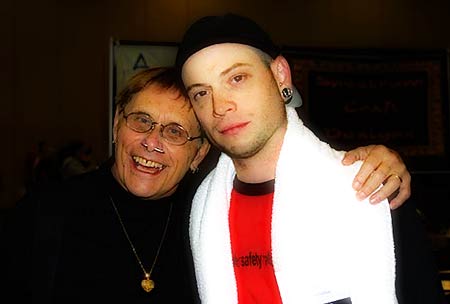
Fakir Musafar and Sean Christian at a previous APP convention
(Okay, maybe that’s not fair. It wasn’t that I didn’t like him, I just didn’t quite know what to make of him — he was almost too nice. You could have walked into the room with an angry badger gnawing at your ankle and he would have given you a hug, complimented you on your boots, then quietly slipped the badger a fifty and told it to get lost.)
It wasn’t that he was a bad guy — quite the opposite — but overly friendly people tend to make me nervous. I would have to get over it though, as Shannon, Rachel and I were going to be joining him, Schane Gross and Crystal Sims (co-owner of Evolution Body Piercing in New Mexico and outgoing APP Secretary) for dinner that evening. We arrived at the Mandalay Bay to find that our reservations had been bumped back, so we decided to survey the casino.
Apparently, the rumors about the Riviera were true.
To this point, I’d been pretty underwhelmed by Las Vegas. For all of the sensational party stories I’d been told, all I’d really acquired by my third evening there was an intense desire to not get fat and boring when I reached middle age — and I thought this was Vegas’ fault. As it turned out, the Riviera was not really indicative of what the city had to offer as a whole. After a matter of minutes inside the Mandalay Bay — with its high ceilings, attractive lighting, and atmosphere where one could go bankrupt in style — I once again believed that I could, in fact, find some decadent debauchery in Las Vegas. Once we got into the restaurant and received our menus though, I couldn’t decide whether to laugh or break down into a gentle sob; these were the most insanely-priced meals I’d ever seen in my life. It looked like something The Onion would publish.
(Honestly, $65 for sea cucumbers with abalone? Maybe this reflects poorly on me, but I wouldn’t pay $65 if a childhood friend were being held hostage and everyone was chipping in on the ransom money, much less for the slimiest, most texturally-upsetting wonders the sea has to offer.)
After eating a $7,000 plate of pork and feeling horribly guilty on multiple levels, we made our way back to the Riviera, where I decided that it was time to come out of my shell a little and actually make some friends at the Splash Bar. After all, these were people that I’d been casually running into for a few days now, and I felt confident that I’d be able to remove myself from the shadows and have some intelligent conversations. Also, I’d been drinking since noon. Anyhow, my plans for human interaction seemed to be falling flat until I once again ran into Ryan Ouelette, now accompanied by the recently-arrived Jesse Villemaire (IAM:JesseV), who was forced by US customs to delay his trip on account of a youthful indiscretion that still lingered on his permanent record. At one point in our conversation, one of the evolutionary anomalies from the dart convention became interested in the portfolios of scarification work that Ryan and Jesse — both accomplished scarification artists — had brought with them. Not entirely sure what he was looking at, Jesse explained the (very, very) basic theories and principles behind cutting and branding, both of which seemed to intrigue this gentleman — who proceeded to draw a rough sketch of a brand that he seemed keen on having Jesse perform. When informed that the design was entirely unfeasible as a brand, but that it might work as a tattoo, he then commissioned Jesse to tattoo it onto him, leading to this exchange:
Jesse: But ... I’m not a tattoo artist.
Cletus: Aw, that don’t matter!
Jesse: Well ...
Cletus: Oh c’mon! How much ya gonna charge me?
Jesse: Five dollars?
Cletus: Sounds good to me man! Let’s do it up!
Jesse: But I don’t know how to tattoo!
Cletus: Shit, for five bucks I’ll let ya learn! Haw haw haw!
(You couldn’t make this up.)
Fearing the transmission of contact-stupidity and rapidly losing faith in humanity, I snuck away and spent the remainder of the evening talking to the lovely Schane Gross, the APP’s new Treasurer and arguably one of Wichita’s most successful businesspeople. Maybe it was the potentially volatile blood-alcohol level I was sporting, but I couldn’t get over the fact of how warmly I was being received by the APP members — especially the board. In my mind, it could have easily gone the other way; I could have been seen as The Narc the entire week, but everybody was more than willing to keep me informed and make me feel totally welcome.
I thought of Shannon’s talk earlier in the day, and how I had seen so many people that had never “gotten it” before come around and gain a new perspective on BME right before my eyes; it was becoming increasingly clear that the “us and them” mentality was quickly losing relevance, and that new bonds and alliances were being formed. I couldn’t help but think that exciting things were on the horizon.
Suddenly, the clock struck 5:00 AM, and I remembered that the week was only half over. Slowly, I ambled up to my room, collapsed onto my bed, and proceeded to get one of the most urgently required sleeps of my entire life.
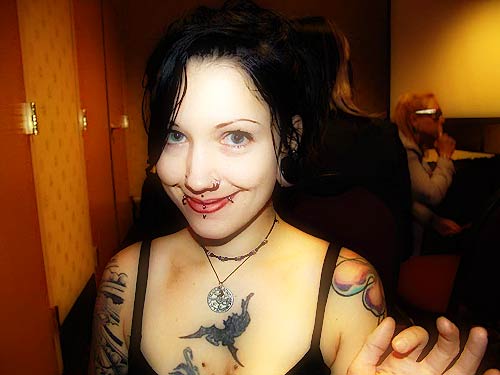
Voted “hottest piercer”

